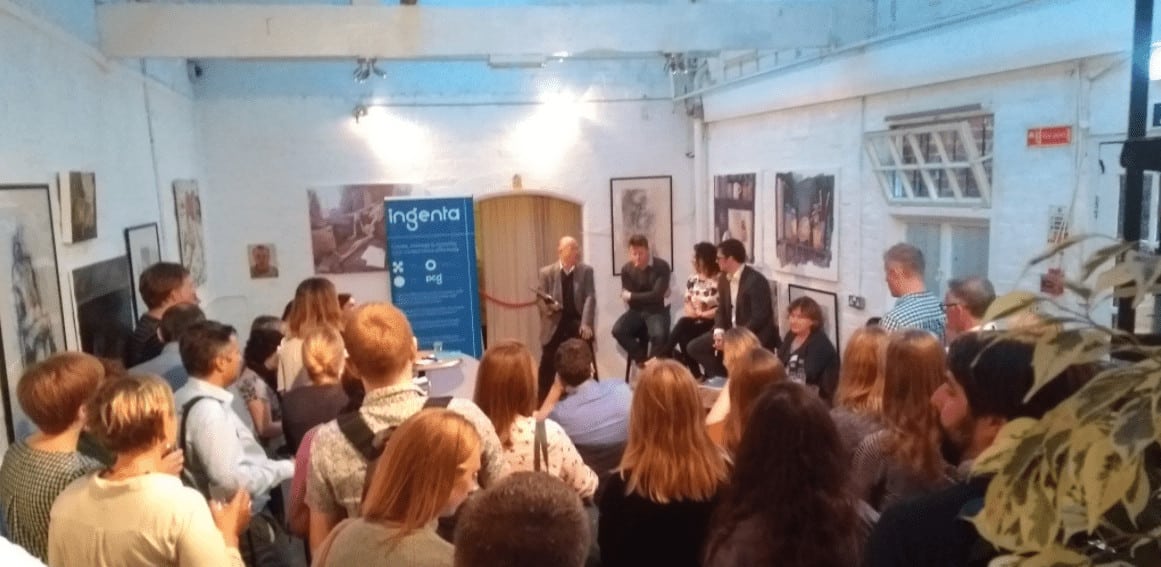Thoughts from BookMachine’s latest event ‘Scholarly Publishing: Crossing the Rubicon’
The Jam Factory, Oxford, 7 September 2017
Last Thursday, as I trundled slowly towards Oxford (kicking myself for accidentally catching a slow train – who knew there were quite so many stations between Reading and Oxford?!) I wondered what was in store at BookMachine’s latest event, ‘Scholarly Publishing: Crossing the Rubicon’. The venue, The Jam Factory, Oxford, was alive with conversation and had a very welcoming atmosphere. Winding my way through tables of busily socialising people, I found the room where the discussion was taking place.
There were four engaging speakers on the panel. Phill Jones, Director of Innovation at Digital Science, a company who invest in and nurture research start-ups creating software to aid scientific research; Charlie Rapple, Sales & Marketing Director and co-founder of Kudos, a platform which increases research impact by driving discovery and facilitating the sharing of academic work; Byron Russell, Head of Ingenta Connect, a publisher-facing content management system that enables publishers to convert, store and deliver digital content; and Duncan Campbell, Director of Digital Licensing and Sales Partnerships at John Wiley & Sons, ranked ninth on the Publisher’s Weekly list of the world’s 50 largest publishers, 2017. Bringing together speakers (and an audience) from both large, established publishers and newer, often technology-based start-ups, led to some interesting discussion on the relationships between the two; the responsibilities of each; and whether one or the other is best placed to cope with the disruptive forces in publishing – or themselves be disruptive.
The discussion generated by the panel was wide-ranging and insightful, broadening my understanding of the various challenges, relationships and roles in publishing. It made me think more deeply about the hugely influential and clearly disruptive issues looming over the industry, as well as the ideas and innovations which currently exist around the edges of the industry, which meet niche requirements today, but which could, in time, disrupt, engulf or evolve the whole publishing landscape.
Insights and topics of discussion that I found particularly intriguing include:
• The symbiotic relationship between start-ups and established publishers
The opening discussion about innovation in publishing included the suggestion that it is more difficult for established companies to innovate – something easier for new-comers. However, there was also an agreement that innovation is a necessity at every tier of the industry. The conversation moved on to the common practice of publishers supporting innovation elsewhere; encouraging and funding the technological start-ups often responsible for floating fresh new ideas. The arguments were put forward that these start-ups rely on funding and support from the publishing establishment, which has a responsibility to nurture them. Yet the establishment in turn rely on the innovation of the start-ups for their own development and evolution – often acquiring them down-the-line as part of their innovation strategy – thus the relationship could be described as cyclical or symbiotic.
• Piracy V. Green OA
Although I was relatively familiar with the term ‘Open Access’, I was not with ‘Green OA’. (This was one of the things I was inspired to google following the event, and consequently am now aware of both green and gold OA!) Reference to green OA was made in discussion of the threat and disruptive nature of piracy in the publishing industry. There was also consideration of how attitudes towards sharing have changed over time – and where the fine line now sits between piracy and OA. It was suggested that in the past, if one academic was to email an article to another based elsewhere, it would have been seen by publishers as an infringement of copyright. Now, perceptions of sharing have evolved, with the industry instead taking an observational approach; monitoring such behaviours with the intent to better understand the market. The distinction was made, however, and agreed upon unanimously by the panel, that sharing on a need-to-know basis remains different from mass-uploads by networks such as Sci-Hub. Yet it was also recognised that such ‘dark’ enterprises are also examples of innovation forcing the publishing industry to evolve. The disruptive impact of such ‘dark’ innovation was nicely summarised by Phill Jones: ‘It has forced the agenda, but at the same time, it’s not the solution.’
It’s testament to how packed, insightful and content-rich the discussion was that I could go on…! Though I won’t elaborate on all the other interesting discussions, I will squeeze in that these included the impact of new business models such as ‘Netflix for journal articles’, how a trend towards trans-disciplinary research and developments in research evaluation will affect publishing, and the future of Discovery Systems.
All-in-all, it was a fascinating and enjoyable evening, and I look forward to future BookMachine events which explore, examine and probe the evolving world of scholarly publishing.

Much of the content for this post first appeared here. All views are my own. If I have misrepresented any of the discussion, or speakers’ arguments, this is down to my own misunderstanding.
Heading image also courtesy of Michael Belcher, Marketing Manager at Ingenta.


